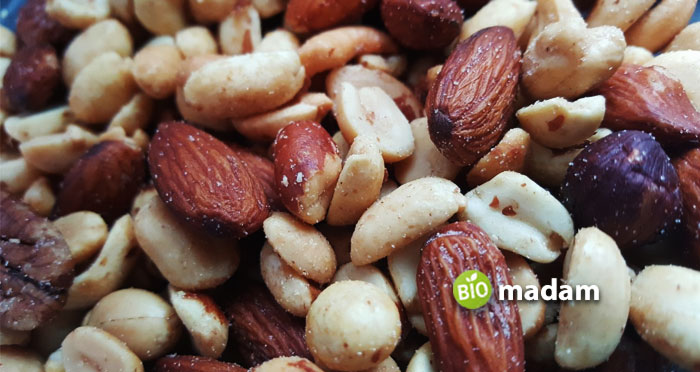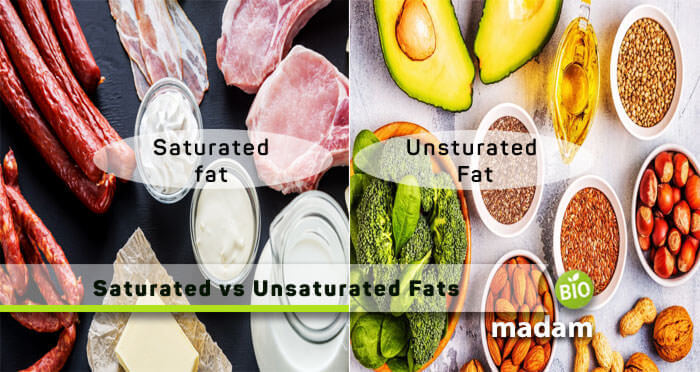Different macromolecules together make up a living body where one such is the lipid. These hydrocarbon-containing compounds are the waxy, greasy, or oily components, playing a crucial role in living cells. A typical example of lipid is fat, which is our main topic of concern today!
Fats are macronutrients used in the metabolism of a living organism. This nutrient is a significant source of energy, helping our body absorb vitamins, keep it warm, and further protect heart & brain health. Fats have more calories compared to any other nutrient. Thus, we can say that it is an essential nutrient for the body to function correctly. Discussing its significant functions, fats help in
- Energy storage and metabolism
- Body temperature regulation
- insulation of the vital organs
Today, we’ll differentiate between the two major types of fats, i.e., saturated fats and unsaturated fats. Let’s begin with their comparison table.
Comparison Table
| Factors | Saturated Fats | Unsaturated Fats |
| Occurrence | Butter, dairy products, meat, cake, cheese, etc. | Vegetable oil, fish oil, sunflower oil, canola oil, etc. |
| At Room Temperature | Solid | Liquid |
| Nature of Bond | Single Bond | Double Bond |
| Type of Cholesterol Increased | Bad Cholesterol (LDL) | Good Cholesterol (HDL) |
| Shelf Life | High | Low |
| Rancidity | Low | High |
| Shape of H-C chain | Straight Chain | Bent |
| Melting Points | High | Low |
| Solubility in Vitamins | Soluble | Insoluble |
| Stability | Very Stable | Less Stable |
Explain Saturated Fats

This type of fat contains only a single bond between carbon molecules, thus, making a long straight chain. They are solid at room temperature. Saturated fats are primarily bad fats because of their direct effect on health. These are commonly grouped with trans fats, present in animal foods, e.g., meat, butter, and other dairy products. Moreover, the recipes made with these ingredients also contain saturated fats, such as cakes and biscuits. Healthy foods such as beef, cheese, and ice cream contain saturated fats, while chicken and nuts have small amounts.
Different Health Associations state that consuming extra saturated fat can increase cholesterol levels, ultimately increasing Low-Density Lipoprotein (LDL). This cholesterol type is the reason behind plaque formation in arteries. Not only has this, but excessive consumption of saturated fats resulted in type 2 diabetes or heart-related issues.
A few sources of saturated fats are:
- Pizza and cheese
- Milk, white chocolate, toffees, cakes, puddings, and biscuits
- Coconut, palm oil, and coconut cream
- Chocolate and chocolate spreads
- Cured meats like salami, chorizo, and pancetta
- Pastries, such as pies, quiches, sausage rolls, and croissants
Benefits of Saturated Fats
An appropriate amount of saturated fats have loads of health benefits too:
- These are involved in making up at least 50% of the animals’ cell membranes
- Saturated fats have antimicrobial properties, which protect microorganisms, e.g., bacteria and viruses, in the digestive tract.
- These fats play a vital role in keeping the bones healthy by effectively incorporating calcium into the skeletal structure
- They also guard the liver against alcohol and other toxins (endotoxins or exotoxins).
Types of Saturated Fats
There are many naturally occurring saturated fats, depending upon the carbon chain. These are long-chain saturated fats and short-chain saturated fats.
Long Chain Saturated Fats
- Stearic acid: 18 carbon atoms long – the primary source is animal fat
- Palmitic acid: 16 carbon atoms long – most common in plants and animals
- Myristic acid: 14 carbon atoms long – rare fatty acid.
- Lauric acid: 12 carbon atoms long – more common in palm kernel oil and coconut oil
- Capric acid: 10 carbon atoms long – abundant in goat’s milk
- Caprylic acid: 8 carbon atoms long – abundant in goat’s milk
- Caproic acid: 6 carbon atoms long – abundant in goat’s milk
Short Chain Saturated Fats
- Butyric acid: 4 carbon atoms long
- Propionic acid: 3 carbon atoms long
- Acetic acid: 2 carbon atoms long
Explain Unsaturated Fats

As the name indicates, unsaturated fats are fats with at least one double bond in their structure. That is why they are liquid at room temperature. Unsaturated fats are also called beneficial fats because they reduce high cholesterol levels in the blood and help prevent heart diseases and stroke. What differentiates an unsaturated fat from saturated fat is the presence of one or more double bonds with fewer hydrogen atoms.
Some familiar sources of saturated fats are
- Olives and olive oils
- Vegetable oils, canola oils, and plant oils
- Fish like salmon, anchovies, tuna, and others containing omega-3 fatty acids
- Nuts and seeds
- Avocados
Benefits of Unsaturated Fats
They play several beneficial roles in improving:
- Blood cholesterol levels
- Ease of inflammation
- Stabilize heart rhythms
- Reduces the risk of heart diseases, and
- Lowers the LDL levels
Types of Unsaturated Fats
Unsaturated fats are majorly classified into monounsaturated and polyunsaturated fats. Let’s briefly go through them one by one:
Monounsaturated Fats
These fats have one unsaturated carbon bond (carbon to carbon bond) in the molecule and are liquid at room temperature but become solid when chilled. If you eat food rich in monounsaturated fats, it helps in
- Developing and maintaining your body cells
- Lowering your LDL (bad) cholesterol level
- Keeping “good” HDL cholesterol levels high
- Controlling the blood sugar and insulin levels
Common monounsaturated fats are olive oil, peanut oil, canola oil, avocados, almonds, hazelnuts, pecans, pumpkin, sesame seeds, and sesame and sunflower oil.
Polyunsaturated Fats
Polyunsaturated fats containing two or more double bonds in their chemical structures are essential fatty acids that the body needs for proper brain functioning and regulating other body functions. They help in:
- Covering nerves
- Building cell membranes
- Blood clotting
- Inflammation
- Muscle movement
- harmful triglycerides
- Reducing blood pressure, etc.
Polyunsaturated fats are mainly present in vegetable oils such as safflower, sunflower, sesame, soybean, corn oils, and seafood. Because of their diversity, these fats are further of two types:
1. Omega-3 fatty acids
2. Omega-6 fatty acids
Omega-3 fatty acids are essential polyunsaturated fats that are also called heart-healthy fats. Omega-3 fatty acids are obtained from plant food such as soybean oil, canola oil, walnuts, and flaxseed. They are also found in fatty fish and shellfish as eicosapentaenoic acid (EPA) and docosahexaenoic acid (DHA), respectively. They help to
Omega-3 Fatty Acids:
- Lower high triglycerides
- Slow the buildup of plaque formation
- Lower the risk of developing an irregular heartbeat
- And also, slightly lowering the blood pressure
Omega-6 Fatty Acids:
Omega-6 fatty acids are polyunsaturated fats found chiefly in liquid vegetable oils like soybean oil, corn oil, and safflower oil. They are suitable for the human heart. Omega-6 fatty acids help to
- Control your blood sugar levels
- Reduce the risk of diabetes
- And also lower high and irregular blood pressure
Differences between Saturated and Unsaturated Fats
Let’s look at the differences between the two, one by one:
Definition
Saturated Fats
All those fats or fatty acids with no double bond are called saturated fats. They, together, make a long straight chain containing carbon and hydrogen atoms.
Unsaturated Fats
On the contrary, fatty acids containing double bonds, such as oleic acid, are called unsaturated fats. These macromolecules can add hydrogen atoms for stability.
Nature of Bond
Saturated Fats
These fats naturally have saturation incorporated in between carbon and hydrogen atoms. In other words, saturated fats have a single bond.
Unsaturated Fats
In contrast, unsaturated fats consist of at least one double bond, further having the capacity to add hydrogen atoms for stability.
Type of Chain Formed
Saturated Fats
These fats form a straight chain due to saturation in between atoms.
Unsaturated Fats
While on the other hand, unsaturated fats make a bent hydrocarbon chain.
Found In
Saturated Fats
Saturated fats are abundantly found in vegetable oils, coconut oils, different nuts, meat, whole milk, etc.
Unsaturated Fats
In opposite, unsaturated fatty acids are rich in olive oil, avocado, sunflower oil, red meat, canola oil, fish oil, etc.
Physical State
Again, the two types of fats differ in their state because of the degree of saturation and unsaturation, so:
Saturated Fats
Such fats are solid at room temperature.
Unsaturated Fats
In contrast, these fats are liquid at room temperature.
Degree in Melting Point
Saturated Fats
All saturated fats have a comparatively high melting point because of the straight chain.
Unsaturated Fats
On the contrary, unsaturated fats have a relatively low melting point.
Effect on Low-Density Lipoprotein
Saturated Fats
These fats have a direct effect on increasing the LDL level, thus, increasing the risk of heart diseases.
Unsaturated Fats
On the other hand, unsaturated fats tend to decrease LDL levels in the blood.
Daily Consumption
Saturated Fats
It is recommended not to exceed 10% of saturated fat consumption daily.
Unsaturated Fats
In contrast to the above one, unsaturated fats can be consumed up to 30% daily.
Influence on Health
Saturated Fats
Excessive intake of saturated fats will increase LDL levels, ultimately resulting in atherosclerosis or heart diseases.
Unsaturated Fats
On the other hand, unsaturated fats can lessen cholesterol levels in the blood.
Conclusion
We have compiled detailed differences between saturated and unsaturated fats for your convenience. Although too much consumption of saturated fats may lead to health issues, it doesn’t mean the macromolecule isn’t essential for a living body. Both types of fats hold equal importance and fulfill almost 20-35% of our daily energy requirements. They are involved in several biological processes, such as the development and growth of a body.

Hello, I would like to introduce myself to you! I am Chelsea Rogers, an experienced blog writer for science articles, holding an MPhil degree. My enthusiasm to grab the best knowledge, let it relate to botany, zoology, or any other science branch. Read my articles & let me wait for your words s in the comment section.

